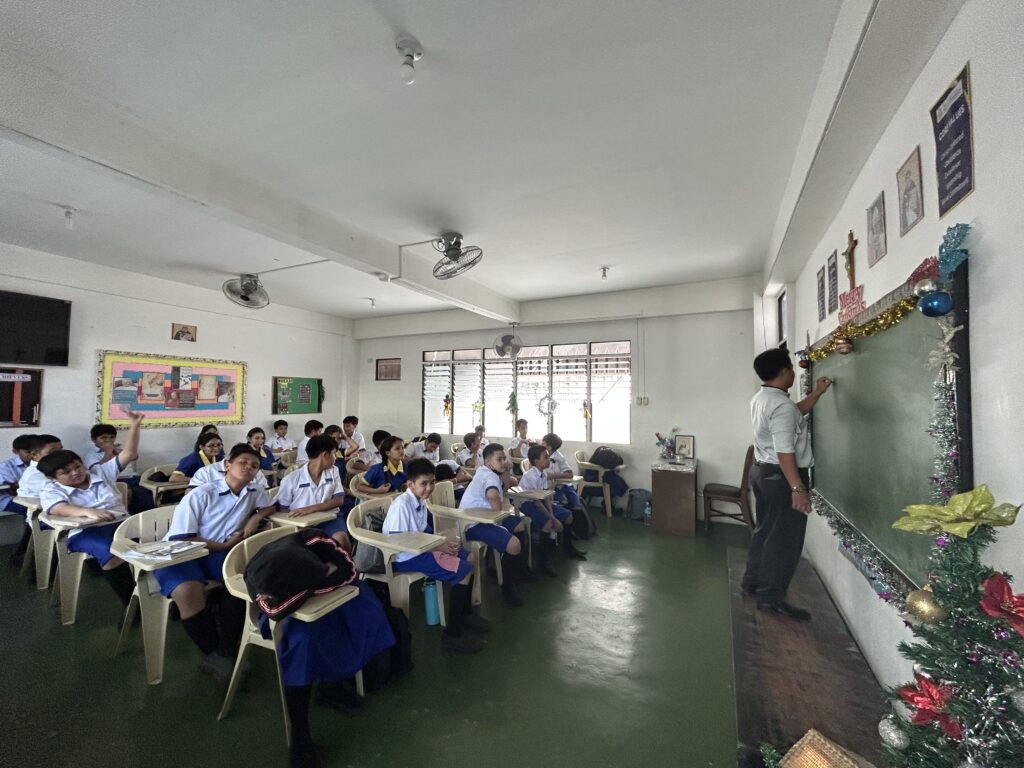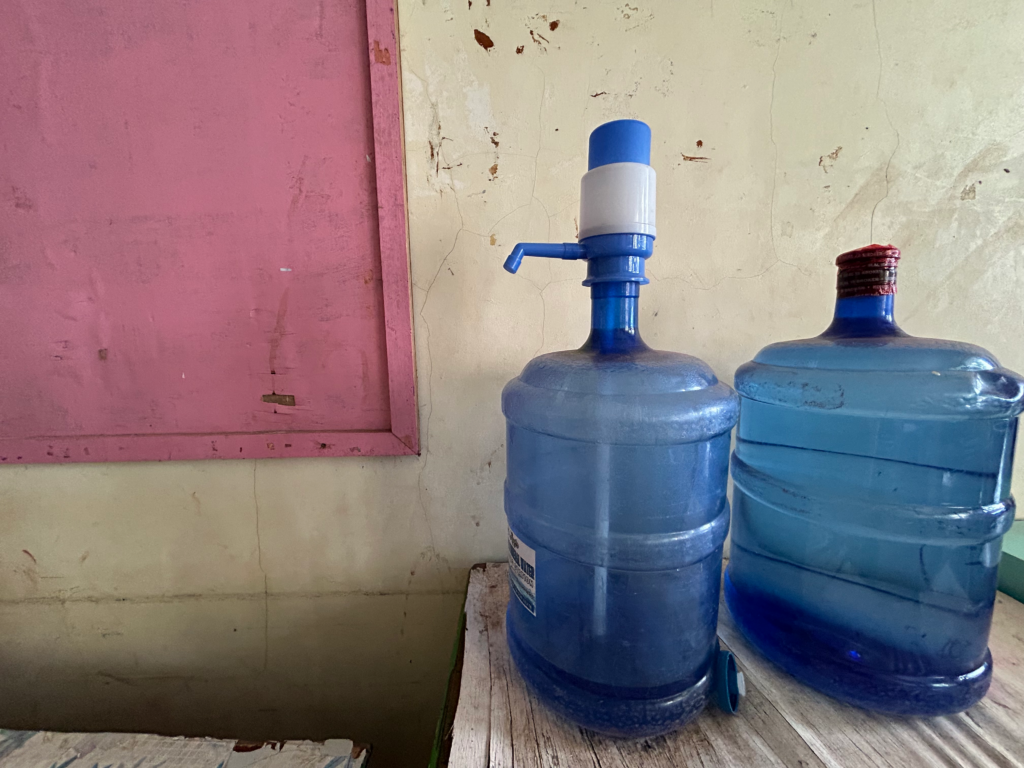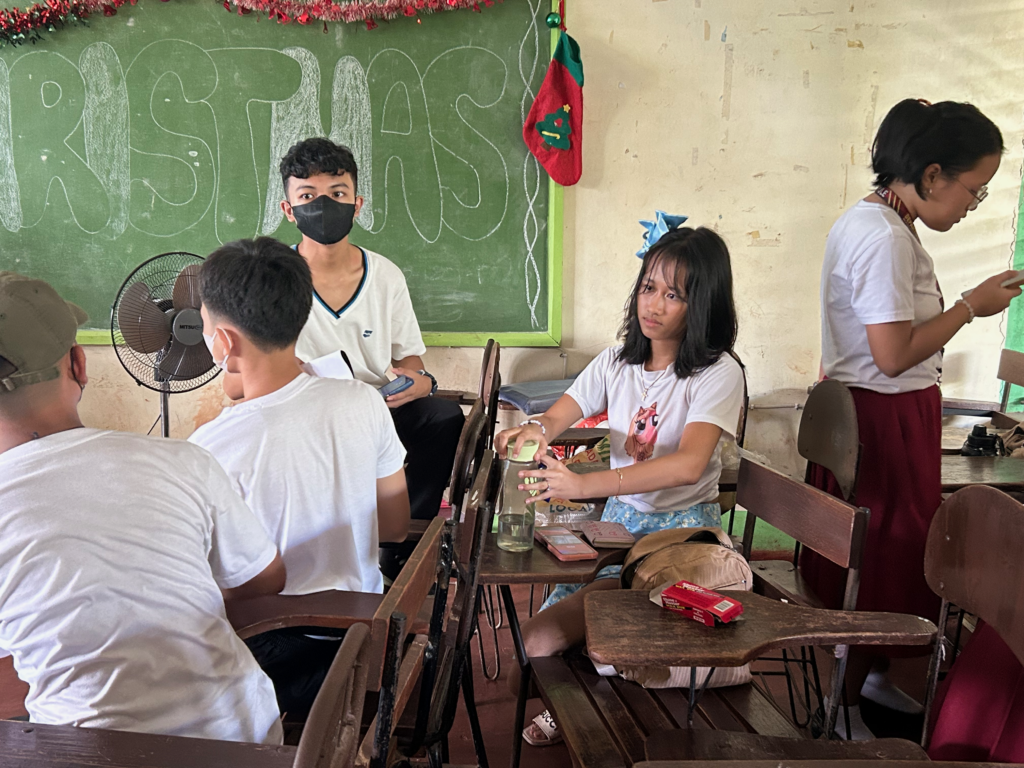[This is the second and last part of a special report on how extreme heat in 2023 impacted the education sector in the Philippines. Click here for the first part.]
CEBU CITY, Philippines – The same analysis by Cebu Daily News Digital (CDN Digital) showed that even private schools, which usually have better facilities and smaller student populations than government-run schools, were affected by the heat last summer.
St. John Paul II Cognition School, a private school in Mandaue City, a highly urbanized metro in Cebu, has smaller student sizes than Leyte National High School in Tacloban City, Leyte. Yet, teachers and students there also complained of unbearable heat.

A classroom inside St. John Paul II Cognition School in Mandaue City, Cebu. Despite having more spacious classrooms and a smaller student population, the school still decided to suspend in-person classes during the summer of 2023 as the extreme heat has become unbearable and dangerous for children walking to the school to attend classes. | Photo by Morexette Marie Erram
The school suspended in-person classes from April 24 to April 28 due to extreme heat – the first time the school did so. At the time, the heat index in Cebu reached dangerous levels, ranging from 38 to 40 degrees Celsius.
Since the majority of their students live nearby and just walk to and from school, Wilmonina Bering, the principal, said officials were worried that the children would get sick or, worse, hospitalized.
“When I see kids walking to the school with scorching heat outside, it pains me. I worry for them, especially their health,” she said in Cebuano.
Children are the most vulnerable to heat, as studies show they have lesser capacity to regulate body temperature than adults. When kids are exposed to unbearable hot weather for long periods, they are likely to suffer from heat-related illnesses.
By 2050, around 33 million children in the Philippines will be exposed to heat waves due to global warming, according to projections from the United Nations International Children’s Emergency Fund (UNICEF).
This means that less than 30 years from now, at least 8 out of 10 Filipino kids will suffer from high heat waves.
A 2021 study in the United States also found that heat adversely impacted learners in the U.S. and other countries and that poor and marginalized students are at a disadvantage.
By collating standard achievement test scores from 58 countries and 12,000 U.S. school districts, researchers discovered that the rate of learning declines when there’s an increase in the number of hot school days.
No similar study has been done in the Philippines. But the group Alliance of Concerned Teachers (ACT) planned to have one soon to get a closer look at how extreme heat affects learners and teachers, said their Rep. France Castro.
In Leyte National High School, teachers like Edsyl Colico expressed concerns over students who endure the hot and humid weather on empty stomachs, making their learning experience more burdensome.
“I feel for the children. Many of them do not have packed lunches or snacks. Some do not even eat well at home. And when they arrive in their classrooms, they have another problem to contend with: the heat,” Colico said.
Even access to clean water is a challenge for these students.
“I keep reminding my students to hydrate, to take a bath if they have water at home. We cannot avoid the fact that some of them have limited to no access to running water every day. Some of them can shower only at night because that’s the time they have water,” Colico said.
Even without the heat issue, there are already clear learning disparities between students from affluent households and those from poorer families. Remote learning widened the gap.
Public school students do not have access to computers and the internet, which are necessary tools for remote learning, said Jose Ramon Albert, a senior research fellow at the think tank Philippine Institute for Development Studies (PIDS).
While many public schools implement the cheaper option of asynchronous remote learning using printed modules, experts said that real-time online learning is still the better option.

These 20-liter gallon containers contain drinkable water for Edsyl Colico’s advisory class at Leyte National High School in Tacloban City. Every month, her students contribute as little as Php5 to have these refilled and delivered to their classrooms so they can refill their water jugs, and stay hydrated throughout the day. These come in handy, especially during hot and humid days, Colico said. | Photo by Morexette Marie Erram
Remote learning also depends on the quality of support students get from their homes, as a 2020 PIDS study found that the latter has a strong correlation with test scores.
“Poor parents, especially mothers, have no time and no capacity to be co-facilitators of learning,” Albert said in an interview. This is because many of them are not educated and need to be away from their children to work.
The lower quantity and quality of home support among poorer households is an obvious consideration for the disparity, said PIDS President Aniceto Orbeta Jr in his 2022 paper.
“One can also expect home conditions of more impoverished families to be less conducive to learning, and this becomes more critical when education happens at home,” Orbeta said.
Some public schools also face a disproportionate number of healthcare workers to handle heat-related illnesses.
For example, Leyte National High School only has two nurses for their over 8,000 students. This meant that a single nurse was expected to handle at least 4,000 students.

This is what the school clinic at Leyte National High School in Tacloban City looks like inside, and it only has four beds. The school has over 8,000 students as of December 2023. During the summer that year, over 1,500 students were rushed to this clinic after complaining of intense headaches, hyperventilation, and asthma attacks, with school officials blaming the unbearable heat as the culprit. | Photo by Morexette Marie Erram
When over a thousand students were rushed to the clinic last summer, nurses like Nancy Britannia had to work double time. At one point, she had to extend her shift up to 9 p.m. to make sure no student was left unattended in the clinic.
Britannia said their clinic needs more nurses, especially now that hotter summers are becoming the norm.
“We’re really hoping for additional manpower in the clinic, more so that summer is coming again soon,” she said.
Experts believe that the warmer temperatures experienced last year, as a result of climate change, will likely worsen the condition of poor children in the Philippines, according to a report from the non-profit organization Save the Children Philippines.
The group said 5.6 million poor Filipino families are exposed to risks and hazards from disasters, including tropical cyclones and heatwaves. It is projected that Filipino children born in 2020 will live in a world where there are nearly five times more scorching heat waves than today.
The extreme heat in the summer of 2023 worsened existing issues plaguing the Philippine education system. The country continues to struggle with poor quality of education, classroom congestion, and substandard facilities, among others.
A 2022 World Bank report on global learning poverty revealed that 9 in 10 Filipinos could not read and understand a simple text at ten years old. The school closures during the Covid-19 pandemic, among the longest in the world, exacerbated the problem.
The 2022 Program for International Student Assessment (PISA) results also indicated that Filipino students are five to six years behind in learning competencies. The Philippines ranked in the bottom 10 out of 81 countries in mathematics, science, and reading comprehension.
On top of this, there is a glaring shortage of teachers in public schools.
During the Senate budget deliberations late last year, it was revealed that nearly 90,000 teaching positions have yet to be filled by the Department of Education (DepEd). For the academic year 2023-2024, the agency planned to hire 9,650 teachers but it was able to fill only 35 percent.
The Philippine Development Plan 2023-2028 admitted that the education infrastructure “continues to grapple with inadequacies” of classrooms, teachers, textbooks, facilities, and modern equipment.
When classes started last August 2023, DepEd recorded over 23 million enrollees, both in public and private schools. Public schools have a high teacher-to-student ratio, sometimes reaching one to 60 in highly congested schools in cities.
Based on the ACT survey, around 7 out of 10 teachers who complained of unbearable heat were handling large classes with over 40 students cramped inside a classroom.
In the case of Leyte National High School, where the average classroom size ranges from 40 to 45 students, some teachers took it upon themselves to address the heat problem. They even asked their students to bring fans and extra shirts.

Students in Leyte National High School during their lunch breaks in December 2023. | Photo by Morexette Marie Erram
When face-to-face classes were suspended for two weeks last summer in Leyte National High School, teachers tried little ways to improve ventilation, including replacing their existing thick curtains with thinner ones to help facilitate airflow.
Selected schools in Eastern Visayas also decided to simply implement shifting. On some days, a number of students would go to school, while the rest would do modular learning.
“The purpose was to decongest the classroom,” said Jasmin Calzita, public information officer at DepEd Region 8. This meant that selected classes would be doing face-to-face classes in the morning while others would attend them in the afternoon, Calzita explained.
But four out of 10 of the teachers surveyed by ACT said nothing was done to address the dire situation in their schools. Majority of them reported having electric fans in their classrooms, but these are not enough, students and teachers complained.
“Even if we have electric fans, it’s like the same thing as throwing back water to the sea… It does absolutely nothing because our environment is already hot,” Anthony Egot, a senior high school student at Leyte National High School, said.
At one point last summer, Egot’s academic performance slightly declined. He said his headaches, triggered by the hot and humid weather, kept on distracting him during classes.
“I guess that’s one of the things that really affected my attention or my focus. And if I had the focus, I would have been more able to listen to my teacher’s lessons,” Egot said.

Students at Leyte National High School heading out after classes during one afternoon in December 2023. | Photo by Morexette Marie Erram
“Even if we have electric fans, it’s like the same thing as throwing back water to the sea… It does absolutely nothing because our environment is already hot,” Anthony Egot, a senior high school student at Leyte National High School, said.
It is summer again, and the Philippines is about to enter a new school year this 2024. This time, though, the DepEd decided to reintroduce the old school calendar to protect teachers and students from the hazard of extreme heat.
After months of deliberation with various groups, the government decided to slowly return to the previous academic calendar, where classes start in June and end in March.
“The idea of having classes during the hottest months of the year is no longer favorable both for the teachers and students. It’s also no longer favorable for the education sector,” Benjo Basas, chairperson of Teachers Dignity Coalition (TDC), told CDN.
Some experts, however, pointed out that the government must do more to address climate change’s impact on education.
“We cannot keep shifting our calendars as we try to keep up with climate change,” Dr. Anna Cristina Tuazon, an Associate Professor at the Department of Psychology of the University of the Philippines Diliman, wrote for her column Safe Space in the Philippine Daily Inquirer.
The Movement for Safe, Equitable, Quality, and Relevant Education (SEQURE), a coalition of education experts, also said the government must allocate a higher budget for education to include disaster-resilient infrastructure, upgraded facilities, and a science-based climate change and climate justice curriculum.
More than this, the group said the government must stop “all economic plunder that (will push) higher the risks of environmental destruction due to foreign and large scale economic activities in Philippine ecosystems.”
“The Philippine education system is just a microcosm of Philippine society. The government is not stopping climate risk projects that destroy forestand coastal ecosystems vital to managing climate change,” SEQURE told CDN. “It is the Filipinos who greatly faced the impacts of the current climate crisis.”
“The Philippine education sector is most affected by these disasters. Even if the Department of Education and other government agencies have climate change adaptations and mitigation programs, it will remain a band-aid solution and high risk and vulnerability of school children and education remain,” the group added.
Bernie Lamograr, the Leyte National High School assistant principal, shared the same sentiment.
“There are leaders who do not believe in climate change but it’s really here. Like we at the bottom really feel it. The government has to do something about this because it’s affecting everyone. They only have short-term solutions, like giving ayuda or financial help. But it should be preventive and curative.”
In the meantime, students and teachers have to mostly fend for themselves again as they face a possibly even hotter summer in 2024. And as early as the first week of March this year, some schools started suspending face-to-face classes once more as the summer heat this year begins to bite again.
Reporting for this story was supported by the Environmental Data Journalism Academy – a program of Internews’ Earth Journalism Network and Thibi.
Heat index data was acquired from the Philippine Atmospheric Geophysical and Astronomical Services Administration (Pagasa), covering the period from January 2022 to July 2023.
Missing data due to technical errors at weather stations (encoded by Pagasa using the negative value -999) were excluded from our analysis. A complete list of the steps undertaken in scraping, cleaning, and analyzing the heat index data can be found on the Data Diary sheet of the DataDoc on Heat Index.
We also used rankings of the Heat-Health Risk Index (HHRI) from the study by Ronald Estoque, et. al, published in Nature Communications, which are available online.
Other datasets included in this story are the online survey by the Alliance of Concerned Teachers (ACT) in March 2023 about teaching experiences during hot and humid days. As to the number of schools that canceled in-person classes due to extreme heat in the summer of 2023, we used Google Advanced Search to find press clippings and reports pertaining to this.